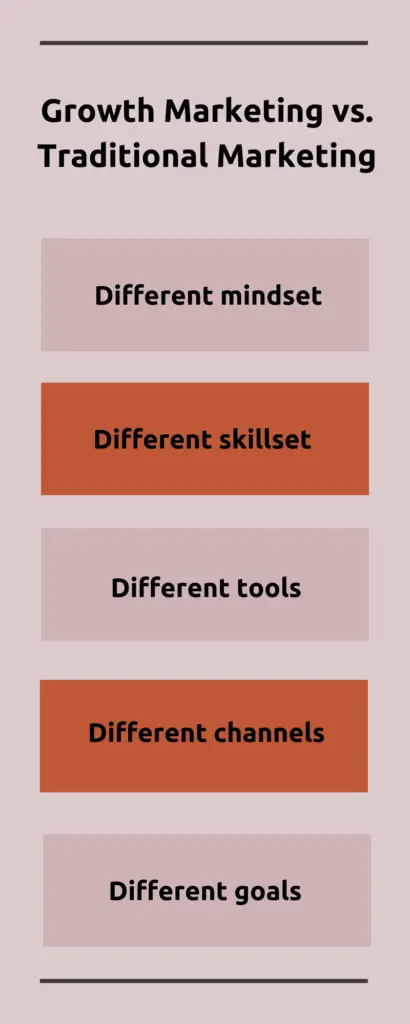I am sure that you’ve stumbled upon the term growth marketing (…at least on this website 🙂 ), but are you sure what that term actually means? Is it the same as digital marketing, growth hacking, or just another buzzword?
What is growth marketing?
| Growth marketing is a process of reaching new customers and retaining current ones, but with an aim to improve, grow the overall business. It is a holistic approach to creating and delivering tailored campaigns aligned to your customers needs, delivered through the most relevant channels. |
Difference between growth marketing and traditional marketing
While traditional marketing usually focuses on selling a certain product, or service using the same, but proven techniques for reaching customers, growth marketing is all about experimenting with marketing channels, messaging and techniques. And more than that — growth marketers are not only aimed at increasing sales metrics, but, as the name says, to find ways to grow the business.
Here’s a typical example of traditional, digital marketing — Google Ads search campaign with the same 30 keywords that lead to the homepage. Okay, surely you’ll get some results, but if you’re not working on your strategy, the returns are likely to diminish over time. Or, Facebook ads with basic targeting and templated banners.
On the other hand, growth marketing should be all about A/B testing (and optimizing, afterwards) to find untapped opportunities in the current, or new marketing channel.
So, for example, a growth marketer should create tailored landing pages for a specific keyword group and run some Google ads with a non-conventional messaging.
As for Facebook ads, good growth marketers would find some hidden interests (check this post: How to find Facebook hidden interests), experiment with ad copy and design. Or, even better — switch to Tik Tok ad campaigns.

…and what’s growth hacking then?
Growth hacking, a term that was super popular a few years ago, was coined by entrepreneur Sean Ellis back in 2010, when he tried to find a marketer that could grow his user base, as quickly as possible. The term was especially popular among SaaS marketers and entrepreneurs (because the industry is highly competitive).
There are five stages in the growth hacking funnel — acquisition , activation , retention , revenue , and referral (or the AARRR funnel).
Growth marketing has its foundation in growth hacking, but as marketing technology has advanced, so has the sophistication of the growth marketing itself.
Core components of growth marketing
Growth marketing focuses on customer relationship building and fostering loyalty; it’s a long-term strategy where authenticity and engagement creates advocacy and organically grows customer lifetime values. — explain at RockBoost.
There are no strict rules when it comes to growth marketing, as I’ve mentioned already that it relies on testing, experimenting, and trying to find unconventional hacks. However, there are some channels and tactics commonly used by growth marketers.
As for core components of growth marketing, here they are:
1. Cross-channel marketing
| Cross-channel marketing is a strategy that leans on, as the name says, interacting with customers (at any stage) through a variety of marketing channels. That way businesses can determine which channels and approaches are the most appropriate for each type of customer. |
Channels that are usually used for this matter are email marketing, push notifications, in-app messages, social media, blog posts, SMS messaging, etc. The thing is to choose a combination of channels that is suitable for your users and their communication preferences.
Yes, the goal is to create a holistic marketing strategy that integrates multiple channels, but to keep focus on the individual user and to understand their communication preferences. It is hard to engage with your audience on several platforms, but the key is to understand their past behavior across each one and build a campaign accordingly.
What are the benefits of cross-channel marketing?
- More visibility since multiple channels gather a wider audience.
- Better personalization since your customers can choose how they will consume your content.
- Increased brand awareness as the audience is greater.
- Consistent, unified messages across all mediums can build a good relationship with customers.
- More statistics that will help you learn about your customers and how to interact with them.
How to implement cross-channel marketing?
- Define your customer persona, in detail.
- Analyze data you already have about your customers (for example, Instagram stats).
- Choose channels that are most likely to be relevant for your audience (it goes without saying that this means that you do some serious research).
- Define messages that you want to promote.
- Design the content for each channel (no need to design everything from scratch, just adjust the main message to each platform).
- (If you have them) integrate your customer data platform (CPD) with your content management system (CMS) to send personalized messages.
- Analyze data again and use the content and strategy that gave the best results.
Example: Starbucks
Starbucks is one of my favorite brands when it comes to creative, yet professional marketing campaigns (…and I am a huge coffee-lover 🙂 ). A few years ago, the company launched a Frappuccino Happy Hour campaign, on multiple channels, that was very successful.
Starbucks used a variety of different channels for this campaign: web, social media, TV, in-app messaging, etc. They were consistent with the message and imaginary they communicated, no matter the channel. Of course, the content was adjusted to the promotion channel, but all together, the whole campaign seemed well tied up. For example, Starbucks also created a different social media identity for Starbucks Frappuccino from its regular Starbucks social presence.
“We’ve got this early spark with Unicorn out there that has really ignited, I think, interest in the product,” said Chief Executive Kevin Johnson.
Apart from having great visuals and promo messages, the company used a variety of cross-promotion tactics (for example, they sent an im-app message with the CTA text “WOOHOO” to find out what’s new when it comes to other summer surprises). Besides, Starbucks promoted their referral and loyalty program, which increased the campaign awareness even more.
The key take out from this example is that Starbucks created a campaign around something worth promoting, they added a scarcity moment (since it was a limited time offer), and was consistent with the messaging and visuals, although customized for each channel.
….Oh, and there were some memes and fun social media moments during the campaign :).
2. A/B testing
A/B testing, or to be precise — multivariate testing, is one of the most common practices among growth marketers. To put it simply, it is a method of testing two variations of the same thing :). It can be used for email marketing, social media campaigns, landing pages, PPC ads, etc.
The idea is to see what works better for the particular audience, the variation “A”, or “B”. The idea is to see which visuals, copy, design, and other features perform better, for each campaign, each audience. Then, you can optimize the campaigns according to the results.
Well, even if you see that, for example, “A” is performing better than “B”, that doesn’t mean that “C” won’t do even better. Keep iterating to enhance performance with every test.
Let’s take Facebook ads as an example. The Meta Business Manager has an A/B testing feature that works really well (before this feature was live marketers used external tools, such as AdEspresso). Growth marketers usually create two ads that promote the same thing, aimed at the same audience, but the visuals are different, the ad copy. Oh, the audience details should be A/B tested too.
A growth marketer could then continue to optimize the ad delivery, monitor stats to figure out which audience segment performs better with the certain ad, and so on.
Useful to check out: There’s this great website to check out, GoodUI, that shares UI patterns and leaked A/B tests from big companies (such as Booking.com, Amazon, Netflix, Airbnb, Etsy, Google,etc.).
What are the benefits of A/B testing?
- Learn and show your brand’s marketing strengths
- Improve the conversion revenue
- Lower bounce rates
- Upgrade your customer experience
- Test new features, or feature tweaks
- Quick results
- Increased sales
How to implement A/B testing?
I bet you’re thinking how can you perform A/B testing on your own? Well, apart from the mentioned Meta Business Manager, there are other tools that have a built-in A/B testing feature, or are created especially for these matters.
A/B Testing Tools to help you out:
Find out more: Here’s a great article that covers a variety of info you need to know about A/B testing: How to Do A/B Testing: 15 Steps for the Perfect Split Test. Also, to stay up to date with the trends in web design – Best Website Design Trends.
Example: HelloFresh
HelloFresh, a meal kit subscription service managed to increase its revenue up to 7%, by implementing learnings they got by running A/B tests.
Since the user base grew, there were a lot more recipes to find on the platform…which made quite a mess when it came to easy navigation. As the company knew how important it is to have a seamless user experience, they’ve decided to test a new control menu. In addition, the new design put more emphasis on upsell opportunities.
3. Customer lifecycle marketing
I’ve mentioned above that growth marketers have a very holistic approach to marketing, and that also means that they follow the customers through their entire lifecycle.
To put it simply, customers need to be marketed on three stages: activation, nurture, and reactivation. Each stage deserves a specific strategy, channels, and messaging.
Activation – the initial stage where growth marketers usually use onboarding and welcome campaigns, (free) trials, and similar tactics. All of these should be aimed at activating the consumer’s attention.
Nurturing – the stage where growth marketers nurture and try to engage the customers. This is the ideal stage for cross-channel marketing strategies.
Reactivation – the stage where customers should be engaged (again) so they make some decisions. This is when growth marketers use loyalty programs, win backs, post-purchase campaigns, etc.
Each customer stage is equally important as customers naturally go through the lifecycle at their own pace. It is up to growth marketers to recognize the right campaigns for each lifecycle stage.
What are the benefits of customer lifecycle marketing?
- Achieve continued sales.
- It is cheaper to repeat business from existing customers, than to attract new ones.
- Increases customer lifetime value.
- Helps with building brand awareness.
How to implement customer lifecycle marketing?
Well, this is something that can’t be explained in a couple of sentences, so I recommend that you check out this two in-depth guides on customer lifecycle marketing:

Example: Outside Magazine
Lifecycle email marketing is one of the most common tactics praised by growth marketers. Outside Magazine’s marketing team knows that sloppily sending emails just isn’t enough. They must come at the right moment, the message needs to be tailored to the lifecycle stage, and they must have a tempting subject line.
Outside Magazine has a daily newsletter that has articles and gear promotions, but just through links. That way the message isn’t too long to read, and it is simple to click on their site and read the full piece, or check the item you are interested in.
What is a growth marketing channel?
| A growth marketing channel is a medium (usually digital, but not necessarily) that a business uses to attract new, engage and retain current customers. There are a number of different growth marketing channels that you can incorporate in your growth marketing strategy. |
Remember, growth is not a one way street — it is data driven, and needs to be optimized constantly (according to the data) to maximize the outcomes.
So, these are the most common growth marketing channels:
- Email marketing
- Search engine optimization (SEO)
- Search engine marketing (SEM)
- Content marketing
- Social media marketing (organic)
- Social media advertising
- Influencer marketing
- Community building
- Affiliate marketing
- Referral programs
- Traditional and unconventional PR
- Sales
As mentioned, optimizing the initial growth strategy should lead my data. Of course, as every growth strategy is different, so are the metrics you should monitor. Here are some metrics you should track, in order to get the most out of the growth channel, and strategy.
- Website traffic (organic, direct, paid, referral, social)
- SEO (keywords, search terms, organic traffic)
- Leads (marketing-qualified leads, sales-qualified leads)
- Email (open rate, reply rate, conversion rate)
- Customer retention (number of cross-sells, upsells, but also churns)
- Customer lifetime value – CLV (total expected revenue from a customer over a time period)
- Monthly recurring revenue – MRR (predictable revenue for each month)
- Average revenue per user – ARPU (the amount of money that is generated from each user)
- Churn rate (percentage of customers who canceled the subscription in a period of time)
- Paid advertising metrics (ROAS – return on ad spend, CAC – customer acquisition cost, ROI – return on investment)
- SEO metrics (keywords a website ranks for and changes in their ranks on search engines)
Examples of growth marketing strategies:
Useful content does the sales on his own
To attract new customers you need to be patient. Hard sales tactics will rarely do the trick. Instead, you want to create a long-term strategy that will first get your customers familiar with your brand and its benefits. That way, the next step, to make the purchase (….or any other action step) will be on their own terms.
Content marketing is great for this matter, since you choose what you want to put emphasis on regarding your business, what makes you different from competitors, etc.
Before you get to content creation, you need to have your customer avatars in place. That way, you can tailor your content to each one of them. The idea is to publish content that has a call-to action: a free offer, a coupon code, opt-in to your email newsletter, etc.
As for the channels where you’ll be publishing the content, they should also be adjusted to the users. For example, social media, paid advertising ads, blog posts, etc. This is a great opportunity to leverage A/B testing and optimize your ads, for example.
There are plenty of great examples, but let’s take a look at the DECKED campaign for camping gear.
The company created a blog post on the topic Gear guide to camping in the back of a truck. They’ve covered all the benefits that this type of camping has to offer, but listed all the necessary gear and accessories needed to make the most out of the experience. My thoughts are that they wanted to attract someone who was researching how to camp in their truck, no matter if they’ve ever heard of the brand.
After reading the article, the potential customers will realize all the benefits that this gear has to offer, and they are already on the website where they can buy everything.
A post like this is a great tactic to get leads into the sales funnel (first stage, top of the funnel, the Fast Lane), and to make the article easily shareable (check the links to social media included in the post).
Not sure how to create a good content strategy? Check out my other blog post: Content Strategy: What Is It & How to Create a Good One [2022].
Gift as a hook to attract leads
Back when I was working in a digital marketing agency, I tested a sales method that really brought me a lot of sales calls and inquiries.
Since I was a contributor at TheNextWeb, I published an article where I mentioned 10 tools based on AI that will change your freelancing career.
Disclaimer: The purpose of the article was to actually give readers some valuable info and tips on what tools are good. Yes — I’ve really tried the tools and did my research.
So, I’ve mentioned the tools, and let’s be honest — a link on TheNextWeb is really hard to get. I’ve reached out to the decision makers from each tool to let them know that I’ve featured them.
Just a simple mail, where I didn’t ask for anything in return:

….and I got a reply from almost everybody! Not only did they thank me, but most of the tools shared the article on their social media (which gave me a lot of exposure), and I’ve scheduled a sales call with more than a half of them.
Okay, so not everybody has the opportunity to feature their prospects in a popular online publication, but my point here is to try to give something for free before you reach out to your leads. You can always mention someone in your company blog, a social media post, newsletter, etc.
Did I make (growth marketing) things more clear?
You see — growth marketing isn’t just another buzzword. In fact, with today’s tools and information, every marketer should be a growth marketer. The focus should be on continuous testing and optimizing the entire sales funnel. Marketing should be closely aligned with sales, so the outcome is — growth.
Growth marketing FAQ:
Is growth marketing relevant only for tech companies?
No, growth marketing is an approach that could help any business (services, digital products, physical products). The idea is to identify the best initiatives that will maximize the outcomes in the shortest period of time.
What should I look for in a growth marketing marketing agency/consultant?
If you are looking to hire a growth marketer, or an agency, I strongly suggest that you consider if they offer services based on what you are looking for (…and not just traditional marketing), if they have the needed experience, and most importantly — if you are a good fit.
When should I hire a growth marketing marketing agency/consultant?
Well, I suggest that first you have a product/service in place, that everything is well prepared for the market. Don’t expect to sell something that is not yet prepared to be sold :). As for the budget, well — yes, you’ll need to make an investment, but you don’t need to burn all of your budget immediately. Start small…but a good growth marketer will probably advise you so.
How can I be successful at growth marketing?
First things first — you need to be well informed, to have all the necessary data and tools so you can act accordingly. Luckily, today you have plenty of resources available regarding each growth marketing channel, templates, tools, etc.
I will do my best to provide you with educational content and growth marketing learning materials.
Remember, growth marketing is a long-term strategy that can build customer lifetime values. Therefore you need to be persistent and patient.



